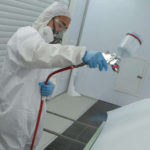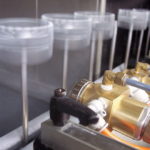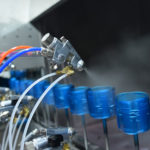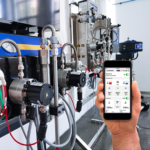 Pneumatic diaphragm pump is a volumetric pump that is driven by a compressed air source and enters through the air inlet and reciprocally deforms through the diaphragm in the diaphragm pump chamber. The working principle of pneumatic diaphragm pump is similar to reciprocating pump. For a long time after the appearance of pneumatic diaphragm pump, there are many inappropriate ways of using it safely and correctly. We have summarized some of problems we have encountered so far for basic guides to operators.
Pneumatic diaphragm pump is a volumetric pump that is driven by a compressed air source and enters through the air inlet and reciprocally deforms through the diaphragm in the diaphragm pump chamber. The working principle of pneumatic diaphragm pump is similar to reciprocating pump. For a long time after the appearance of pneumatic diaphragm pump, there are many inappropriate ways of using it safely and correctly. We have summarized some of problems we have encountered so far for basic guides to operators.
Pay attention to the following when using pneumatic diaphragm pump:
1. Ensure the biggest particles contained in liquid do not exceed the pump maximum safe passage diameter.
2. The intake pressure should not exceed pneumatic diaphragm pump maximum allowable operating pressure. Excessive pressure of compressed air can cause the diaphragm to rupture and damage the pump life, which can cause downtime and personal injury.
3. Ensure the diaphragm pump outlet pressure can accept the highest output pressure at the outlet pipe and ensure the drive air pipe line is cleaned and in a normal working environment.
4. Before starting the diaphragm pump, make sure the grounding screw is firmly fixed. In order to prevent static sparks during use, the wire design should be adopted. The pump foot should be grounded to avoid personal injury.
5. Before starting the pneumatic diaphragm pump, the connecting pipe and the joint must be tightened fixed to prevent sparks generated by the oscillation, impact and friction generated by the operation, and sparks are generated to prevent serious damage. It is preferable to use an antistatic hose for intake source connection.
6. The pump grounding fixing technical requirements must comply with local laws and regulations and onsite special requirements.
7. Regularly check and test the reliability of grounding bolt. The grounding resistance must be less than 100 ohms.
8. It is necessary to maintain good ventilation environment, keep away from inflammable and explosive materials and heat sources.
9. When pneumatic diaphragm pump is in operation, the compressed air source may contain solid particles, do not point the exhaust port to the working area or human to avoid personal injury.
10. When the diaphragm is broken, the transported liquid may leak from the exhaust muffler.
11. When transporting flammable, explosive or toxic and hazardous media, connect the outlet to a safe area away from work area.
12. Use a pipe with minimum of 3/8″ inner diameter and a smooth inner wall to connect the exhaust muffler.
13. If pneumatic diaphragm pump pressure and media leakage during operation, it may cause personal injury or property damage, please do not perform any action on the pump or material tube when the pump is running. To make any change on pump, please turn off the paint supply first then open pressure relief valve to discharge the pressure and liquid in pipe.
14. Before running the pneumatic diaphragm pump, it must be confirmed that the fluid components such as the pump body material and diaphragm material of the pneumatic diaphragm pump will not corrode and chemically react with the liquid to be used, so as to avoid serious safety hazards.
 Pneumatic Paint Mixer
Pneumatic Paint Mixer
When it comes to mixers, most people think of electric mixers. In fact, pneumatic mixers are the best choice. Why is that? Because the pneumatic agitator is safe, explosion-proof, high temperature resistant, and resistant to moisture. Pneumatic agitator is driven by compressed air, no electric power supply, so it does not generate any sparks and the pneumatic mixer itself has overload protection. The functions, etc., These are not possible with electric mixers.
How to choose a pneumatic mixer suitable for your product? Below is basic guidance:
(1) First we need to understand the size of mixing drum, normally available as: laboratory (1-4L), 5 gallons (20L) and 55 gallons (200-250L).
(2) The second is to know about paint viscosity. The viscosity of the general material is in centipoise (cps).
1 centipoise (1cP) = 1 milliPascal. Second (1mPa.s),
100 centipoise (100cP) = 1 poise (1P),
1000 mPas. Seconds (1000 mPa.s) = 1 Pascals. Seconds (1 Pa.s)
(3) Finally, we must confirm the required speed. Generally, the speed of pneumatic mixer is calculated by minute. The pneumatic mixer is generally available for two types of mixing: slow mixing and high speed dispersion.
Slow way is to mix the materials evenly by stirring, such as sedimentation, color mixing, paint mixing, sewage treatment, glue stirring, resin stirring, etc.
High-speed dispersion is to use the shear force of the dispersing disc to disperse the granular articles by high-speed rotation;
Low speed mixing mixer
The low-speed mixing mixer uses a (fkeli) piston-type air motor as power source to achieve mixing of paint.
High speed dispersion pneumatic mixer
The high-speed dispersing pneumatic mixer uses a (fkeli) vane-type air motor as a power source to achieve high-speed shearing.




